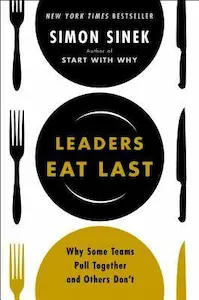Leaders Eat Last - Summary
Simon Sinek

Introduction
In his book “Leaders Eat Last,” Simon Sinek explores the concept of leadership and provides insights into how great leaders create a culture of trust, collaboration, and success within their organizations. Sinek argues that true leadership is not about rank or authority but about taking care of those we lead. By putting the needs of others before our own, leaders can inspire and motivate their teams to achieve remarkable results. This book summary will delve into the key ideas presented by Sinek, highlighting examples and anecdotes to illustrate his points.
The Biology of Leadership
Sinek begins by discussing the biological aspects of leadership, drawing upon the chemical reactions that occur in our bodies when we experience trust and cooperation. He explains how the hormone oxytocin, often referred to as the “trust molecule,” plays a vital role in building strong relationships and fostering teamwork. By creating an environment where trust is nurtured, leaders can enhance collaboration and productivity within their organizations.
The Circle of Safety
One of the central themes in “Leaders Eat Last” is the concept of the Circle of Safety. Sinek emphasizes the importance of leaders creating a safe and supportive environment for their teams. He argues that when individuals feel safe within their organization, they are more likely to take risks, be innovative, and contribute their best efforts. Sinek supports his claims with numerous examples, such as the story of Bob Chapman, CEO of Barry-Wehmiller, who prioritizes the well-being of his employees and has seen remarkable success as a result.
The Impact of Leadership
Sinek explores the profound impact that leadership has on individuals and organizations. He highlights the story of Captain William Swenson, a Medal of Honor recipient, who risked his life to save his fellow soldiers during a battle in Afghanistan. Through this example, Sinek illustrates the power of selfless leadership and the impact it can have on those being led. He argues that true leaders prioritize the well-being of their team members and are willing to make personal sacrifices for the greater good.
The Importance of Purpose
According to Sinek, great leaders inspire action by communicating a clear sense of purpose. He emphasizes the significance of understanding the “why” behind our actions and aligning our values with our work. Sinek shares the story of Herb Kelleher, the co-founder of Southwest Airlines, who built a successful company by focusing on a purpose beyond mere profitability. By prioritizing the well-being of employees and customers, Kelleher created a culture of loyalty and excellence.
Building Trust and Cooperation
In “Leaders Eat Last,” Sinek stresses the importance of building trust and cooperation within teams. He provides examples of successful organizations, such as Zappos, where leaders prioritize the development of strong relationships among employees. Sinek argues that when individuals feel valued and supported, they are more likely to collaborate, share ideas, and work towards common goals. By fostering an environment of trust, leaders can unleash the full potential of their teams.
The Role of Leaders in Times of Crisis
Sinek explores the role of leaders during challenging times and how they can effectively navigate crises. He shares the story of James Sinegal, the co-founder of Costco, who prioritized the well-being of his employees during the 2008 financial crisis. Despite the pressure to lay off workers, Sinegal chose to retain his employees and provide stability during uncertain times. This example demonstrates the importance of compassionate leadership and the long-term benefits it can bring.
The Impact of Technology
The book also delves into the impact of technology on leadership and organizations. Sinek discusses how the rise of digital communication has affected human interactions and the sense of belonging within teams. He emphasizes the need for leaders to create opportunities for face-to-face interactions and foster genuine connections among team members. By leveraging technology as a tool rather than a substitute for human connection, leaders can maintain a sense of camaraderie and collaboration.
The Power of Empathy
Sinek highlights the significance of empathy in leadership and its ability to foster trust and understanding. He shares the story of General George Marshall, who demonstrated empathy towards his soldiers during World War II, leading to increased morale and dedication. Sinek argues that leaders who genuinely care about the well-being of their team members can create a sense of belonging and loyalty. By practicing empathy, leaders can build strong relationships and inspire their teams to achieve greatness.
The Need for Ethical Leadership
Ethical leadership is another crucial aspect discussed in “Leaders Eat Last.” Sinek emphasizes the importance of leaders who prioritize ethical decision-making and hold themselves accountable. He shares examples of leaders who have failed to uphold ethical standards, leading to the erosion of trust and the downfall of their organizations. Sinek argues that leaders must set a positive example, act with integrity, and make decisions that benefit the collective rather than personal gain.
Conclusion
“Leaders Eat Last” provides valuable insights into the qualities and behaviors that define exceptional leaders. By prioritizing the well-being of their team members, creating a safe and supportive environment, and leading with purpose and empathy, leaders can inspire their teams to achieve remarkable results. Sinek’s book is a compelling reminder that true leadership is not about authority or power but about selflessness and service. By adopting these principles, leaders can create a positive and lasting impact on their organizations and the lives of those they lead.